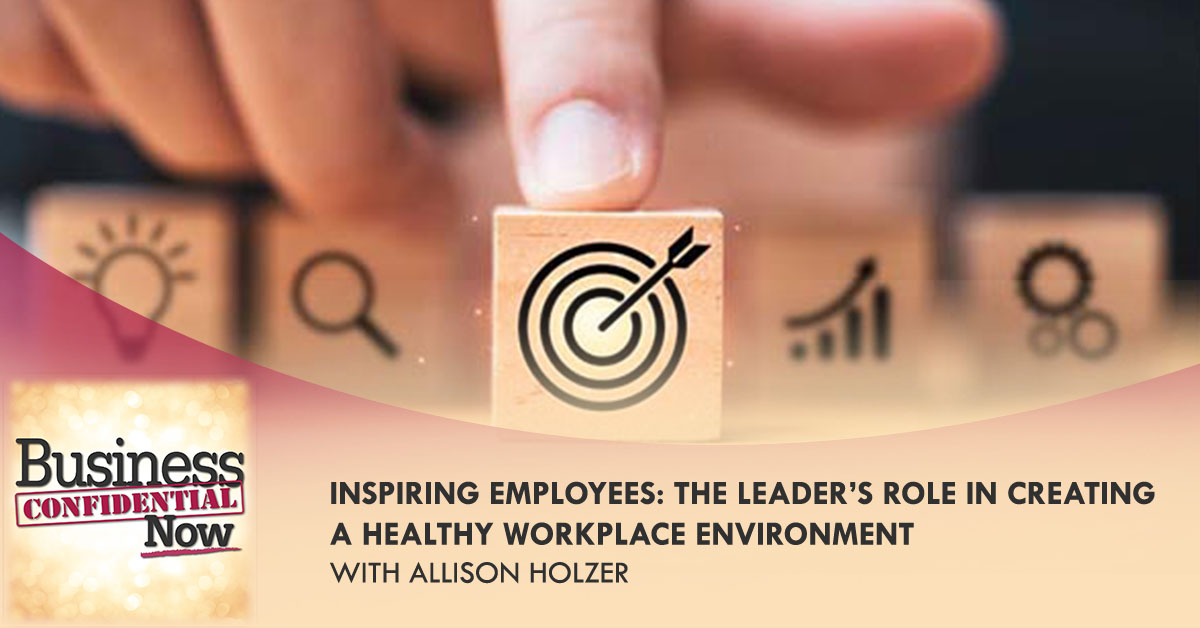
Photo Credit: © iStock|Natali_Mis
Inspiration is key to a healthy workplace environment. As a leader, it is your job to not only inspire yourself but your people too. Because once you understand what inspires your people, you’re getting a lens into their core underlying motivations. You are seeing what matters to them the most and that can really boost a team’s morale. Learn how to inspire your team with your host Hanna Hasl-Kelchner and her guest for today, Allison Holzer. Allison is the Co-CEO & Chief Innovation Officer of InspireCorps. She is also the co-author of the business and leadership book, Dare to Inspire. Join in today’s episode to understand what drives the engines of inspiration in yourself and in your teams. Get inspired today!
What you’ll discover about inspiring employees and its impact on the workplace:
- Inspiration is personal. What inspires one person may not inspire you.
- The importance of inspiring employees and understanding what inspires people in their job
- How managers and executives can start inspiring employees
- How to address the issue of trust
- How to spark inspiration and keep employees inspired
- The most important thing leaders need to know about inspiring their employees
Guest Bio
 Allison Holzer is a master-certified coach and advisor who partners with leaders to drive stronger engagement, culture, and business results through innovative people strategy. She draws from 20 years of expertise working with diverse and global leaders on unlocking new awareness and inspiring performance for themselves and the organizations they lead. Allison holds a B.A. in psychological brain sciences, with an emphasis on learning and cognition, from Dartmouth College and dual master’s degrees in education and Fine Art from American University. She is co-author of the business and leadership book Dare to Inspire and recently released a TEDx talk called Unpack the Power of Inspiration to Shape Your Future.
Allison Holzer is a master-certified coach and advisor who partners with leaders to drive stronger engagement, culture, and business results through innovative people strategy. She draws from 20 years of expertise working with diverse and global leaders on unlocking new awareness and inspiring performance for themselves and the organizations they lead. Allison holds a B.A. in psychological brain sciences, with an emphasis on learning and cognition, from Dartmouth College and dual master’s degrees in education and Fine Art from American University. She is co-author of the business and leadership book Dare to Inspire and recently released a TEDx talk called Unpack the Power of Inspiration to Shape Your Future.
—
Inspiring Employees: The Leader’s Role In Creating A Healthy Workplace Environment With Allison Holzer
Inspiring employees and getting them to be more engaged in their work and the mission of the organization can sometimes feel like pushing a mule uphill. Our guest says that inspiration and inspiring employees are essential leadership skills. When we come back, we’ll find out exactly what she means by that. Stay tuned.
—
I’ve got a great guest for you. She’s Allison Holzer. Allison helps leaders drive stronger employee engagement, culture, and business results through innovative people strategies as a Master Certified Coach and Advisor. She draws from many years of experience working with diverse global leaders on unlocking new awareness and inspiring performance for themselves and the organizations they lead.
She’s the co-author of the book, Dare to Inspire, and she’s been featured in a TEDx Talk. Her topic is Unpack the Power of Inspiration to Shape Your Future. Since business leaders are empowered and responsible for shaping the future of their organizations, I am super excited to have Allison join us and give us some tips on inspiring employees. Welcome to the show, Allison.
Dare To Inspire: Sustain The Fire Of Inspiration In Work And Life By Allison Holzer, Sandra Spataro, Jen Grace Baron
Thank you, Hanna. It’s a pleasure to be here.
It’s great to have you. Inspiring employees and this whole concept of inspiration in the workplace is intriguing. I have to admit it sounds a bit like waving a magic wand. I’d love to get a better understanding of what inspiration is. What do you mean by that?
I’m happy to speak about that. The first thing that I’ll say is that I understand what you’re saying about how it feels like a magic wand. What I thought was so fascinating when we did the research for our book on inspiration in the workplace is when I asked people about times when they felt most inspired in their work and in their lives, they could answer the question easily. We know what the feeling feels like, when we have it, and when we don’t. Yet, it’s hard for people to articulate what is actually is. When I ask people what that is to describe that feeling that they have, that’s a bit harder.
The good news is we know when we have it and we know when we don’t. What we’ve offered is a way to think about defining it so that people can better understand it. What we discovered is inspiration is a bit different than engagement, even happiness, or the concept of flow that you might hear about in the workplace as well.
With inspiration, there are two things that are occurring at the same time. When you’re inspired, you see new possibilities. Those are the things that weren’t there before. You’re opened up to new ideas. The emotion cultivates that in you. At the same time as feeling more open to new ideas, you also feel this heightened urge to take action. You feel more motivated to act on those ideas. You can imagine why that is a powerful combination. You’ve got new thinking and new ideas and you feel more compelled to take action. It propels you forward, almost like rocket fuel, towards new creative and exciting goals and ideas that you’re working on.

Inspiring Employees: Two things occur when you’re inspired. One, you see new possibilities and things that weren’t there before. And two, there is this urge to take action.
That is a great combination. Who wouldn’t want that? Here is the big question. How do you spark inspiration in others? How does an executive manager or entrepreneur begin inspiring employees? Could you give me an example?
One of the things that we’ve learned is how inspiration is truly personal in terms of what inspires each individual. We discovered these different engines of inspiration, but they are pathways that make it more likely for inspiration to occur. What those pathways are to you might be different to me and to somebody else.
Inspiration is truly personal in terms of what inspires each individual. Click To TweetPart of what managers have to be doing is understanding their employees and getting into their psyche to understand what is it that does uniquely inspire them. They can do that by asking a variety of different types of questions to understand them. It’s almost taking a coaching approach to management. What we’re hearing is incredibly important. We hear a lot about how employees want their managers to take more of a coaching approach in terms of how they interact with them. It’s a skillset that we see managers focus on developing.
Ask your employees using coaching questions to think about a time when they were inspired. Where were they? What were they doing? What was most important to them? What were the types of values that they were aligned with and expressing during those times? Usually, when people begin to look back, they’ll notice patterns in things that inspire them.
I’ll give you a few examples. One example from the book is the environment. I remember we interviewed several different leaders. When they talked about the places where they got most inspired, they said, “It is about my environment. When I’m out walking in nature, when I’m in a museum looking at art, or when I’m even in my own office but I’m creating something in the environment around me that is moving, that sparks inspiration.”
That’s unique because there are some people who say, “I don’t even notice my environment. That’s not that important to me.” For some, the environment matters. When they realize that about themselves, then they can begin to craft and think, “If I’m not inspired now, I need to either change my environment or go to a different environment. I need to think about how I can utilize my environment to shift those feelings.”
Another example that is interesting and I hear a lot of leaders talking about is the idea of unstructured think time. We are so busy in our lives. We’re constantly receiving information and being almost bombarded with new information at every moment. At the same time, we’re stretched across different meetings and demands in the workplace.
Yet, what I keep hearing over and over again from leaders at all different levels is, “I get my most inspired ideas when I have a chunk of time to let my mind wander and think creatively. That’s when I get my greatest ideas about new strategies, new initiatives, something that I want to move forward, or some problem that I’ve been trying to solve and I haven’t been able to figure it out.”
If we notice about ourselves that having these bigger chunks of time for unstructured thinking is a place where we get inspiration, then we can design around it. We can say, “That’s a part of my work. That’s not just me sitting around daydreaming. That makes me better at my job.” It gives people permission when they understand what inspires them to begin to craft their workplace in a way that allows them to tap into those feelings. Inspiration is fuel more often and when they need it. It also helps managers think about that for those that they lead. They’re like, “How do I, as a manager, support my employees to do that for themselves and create opportunities for them?

Inspiring Employees: If you know what inspires you, you can begin to craft a workplace that allows you to tap into those feelings. Instead of daydreaming, you can actually make it a part of your work.
It’s interesting because I can imagine some people saying, “When I have unstructured think time, it’s inspirational. It works for me. When I see somebody else doing it, they’re daydreaming and goofing off.” Inspiration doesn’t exactly strike on a schedule, does it? I can see people taking advantage of that unstructured think time.
We have a culture where there is a tendency to almost shame others for something that doesn’t look outwardly productive. In fact, the example that you gave is interesting. I was talking to a leader. He was sharing about unstructured think time. He was saying, “I had this day in my office. I took a few minutes to sit down. I was sitting down in a chair and reading a book.” The book was related to his work. He was using it for some creative think time. Somebody walked by his office and they saw him sitting and reading. It became the joke of the day. They were telling other people, “So and so was sitting in his office, kicking up his feet, and reading a book.” They teased him about it.
He said, “I was upset by that because I was having a moment that was important for my work. I was doing some really deep thinking and solving some important challenges, but on the outside, it doesn’t look ‘productive.’” We value so much what outward productivity means and looks like. We need to rethink how we view productivity and results. We need to allow each other and ourselves to have more space to tap into the emotions that generate better results. Inspiration drives better results and it also drives greater well-being. We can look outwardly productive a lot, and then we can burn ourselves out and we’re not bringing our best to the workplace anymore. That’s truly a tragedy.
I like what you said about looking productive because how many times do people look productive, but they’re not? Those folks are forcing themselves to stay at the computer or late in the office if they had face time. They’re like, “I was there until 9:00 PM.” Did you get anything done? Was it meaningful? I get your point.
By the same token, what I’m sensing here as an underlying theme, whether it’s a manager speaking to their reports to find out what inspires them, what motivates them, and what gets them get their juices flowing or somebody reading a book that they are doing something that is productive, moving the mission of the organization, moving strategy forward, and solving problems, there seems to be this immense need for trust. Not every organization is high in trust. When you’re counseling somebody, how do you address that issue?
That’s such a good point because it does require trust. Trust is reciprocal. In order to be given, it needs to be received. In order to be received, it needs to be given. A lot of times, when we’re working with teams and organizations that are lower in trust, we are working with them on rebuilding trust by giving it, which feels unnatural to people who are in a low-trust environment.
Trust is reciprocal. In order to be received, it needs to be given. Click To TweetIf you’re in a low-trust environment, you’re going to be protective. You’re going to put up walls and shells. The last thing that you’re going to do is give trust. It feels very counterintuitive, but it’s truly a way that people can begin to open up and be a bit more vulnerable with each other and understand each other. We have a whole trust model that we utilize, and I won’t get into that. There are different types of trust. A lot of it is about understanding each other better and understanding each other’s strengths that we bring to the table so that we’re not projecting our own values and what we think is productive onto others.
At the end of the day, it’s understanding, “You might bring different strengths or a different way of doing things to the table, but at the end of the day, we’re on the same team. As long as we’re producing the results that we need to produce, then that’s okay. We can have different ways of getting things done. You can read your book and I can do my thing. As long as we’re coming together as a team and we’re all contributing and getting the results that we need, then that’s what matters.” A lot of this, too, is understanding each other more. Inspiration can help cultivate that. When you understand what inspires people, it’s almost like you get a lens into their core underlying motivations and what matters to them.
I’m sure you’ve seen a lot of the statistics that have been coming out about the Great Resignation, reshuffling, and why people leave jobs. One of the top reasons why people either stay or leave is a sense of meaning and purpose in the workplace. They feel valued. They feel like they understand why they’re there. Meaning and purpose, out of our research, are the number one driver of inspiration. If you do one thing to try to tap into inspiration for yourself and others more, that’s the place to focus the most. It is what gives people meaning and purpose because we’ll inspire them.

Inspiring Employees: One of the top reasons why people leave or stay is because of their meaning and purpose. People want to know that they are valued. Meaning and purpose is actually the number one driver of inspiration.
Oftentimes, when we tap into our own meaning and purpose, not only does it inspire us, but it also inspires the people around us. People around us can feel that we have a sense of purpose and meaning. They feel that passion in what we say. If I’m a leader and I’m tapping into my meaning and purpose and I’m talking about the meaning and purpose of the organization, emotions are contagious.
People start to feel that and draw energy from it. That’s an important part of trust as well. We need to be tapping into an understanding of what gives each other meaning and purpose and be okay if it’s different. If what gives you meaning and purpose is different than what gives me that, we need to understand it in each other.
That’s fair enough. In your work with organizations, have you found that there are differences as far as generations go in the workplace when it comes to inspiring employees?
It is interesting that you ask that. There are so many generational differences in terms of values and what people are looking for in terms of their job experience. We didn’t notice particular patterns in terms of engines of inspiration that drive individuals across different generations that we looked at. It wasn’t something that we found. It’s because it’s so unique. We talk about it like it’s a fingerprint. It’s truly unique what inspires each person. Part of the process is cracking your own code on understanding, “What is it that uniquely inspires me right now and how do I tap into that more?”
It’s one thing to spark inspiration. What tips do you have for keeping that flame going? How do you keep inspiring employees?
This is part three of our book. We talked a lot in the first half of the book about how you make the spark happen, and then we get into how you sustain it. One of the things that we talk a lot about is the idea of energy management. If you think about inspiration like fuel, it can be a spark. Sparks are hot and sparky and eventually, they fizzle out. The question is how do you turn that spark into something that’s more like a sustaining flame?
It’s the same for our human systems. I can get worked up, excited, and passionate about an idea and then I lose touch with it, or my day-to-day life comes in and gets in the way. The next thing I know, the sparks have flamed out. This idea of energy management is being attuned to our energy levels and how they’re doing throughout the day.
Energy management is to be attuned to your energy levels throughout the day. Click To TweetWe don’t talk about energy in terms of physical energy. There are these different buckets of energy. There is physical energy and emotional energy, which is more about the quality of the energy that you bring versus the quantity. There is your mental energy, which is your ability to focus on a particular task at any given moment. There is also an energy that has to do more with your spirit, your sense of purpose, or your why at any moment.
These different buckets of energy can go up and down. For example, I might be physically tired, but I feel very purposeful. My purpose and spirit energy is up high, but my physical energy is low. In my mental energy, I might be focused. In my emotional energy, I might be feeling drained, grumpy, or in a negative mood. We work with leaders on how to be attuned to all these different levels of energy, to notice when they’re dipping, and then to use strategies to step in and reset their energy levels.
We talk a lot about the idea of a reset, which can be a 30-second to a 5-minute activity that you do to regroup and give yourself an energy boost. If your physical energy is low, you might use the reset that helps you boost your physical energy. If your emotional energy is low, you might choose something, rather than going on a walk, like music or something that’s going to tap into your emotion.
The idea is you manage your energy throughout the day. When you’re attuned to it, it allows you to stay at a level where you can feel connected to the things that inspire you most and that you’re not spiraling down into a low-energy state where inspiration might fizzle out for you. That’s one of the things that we talk about in terms of sustaining energy.
The other thing that would be important to mention is we look at how to keep coming back to and re-sparking those engines of inspiration. If I’m a leader and I’m leading a team, I know that this team gets fired up and excited when they’re together in the room and when they’re talking about their mission. I’m thinking of a particular client that we work with.
The leader had identified that this was an important practice for their team to stay inspired. If I know that about my team, then I’m going to make sure that I build that into our system so that we are doing that regularly. We’re tapping into those engines of inspiration intentionally and regularly, whether it’s weekly, every other week, or whatever is manageable for your schedule. We see a lot of leaders doing that.
There’s another leader that we work with who taps into strengths. Strength is something that fires up her team where they get to hear about each other’s strengths or acknowledge each other’s strengths. That leader built that into their check-ins when they do their team check-ins. These types of ways of coming back to and bringing the conversation back alive regularly are also important in terms of sustaining inspiration.
You can do that in creative ways, too, with your performance management systems. You can do that by building in questions that allow people to talk to their managers openly about what inspires them and what they’re doing to be able to bring that into their workplace or tap into it outside of the workplace. Those are good performance management systems. Ask questions that allow and help employees to think about where they get inspiration from and how they can tap into it regularly.
Those are some great ideas. I appreciate your sharing that. In the short amount of time that we have left, what do you think is the most important thing you want leaders to know about inspiring their employees?
The first and most important thing that I will always share with leaders is that it is truly a leader’s first job to inspire themselves. We talk about this in our research and our work. Emotions are contagious. Inspiration is an emotion like others. For you, as a leader, when you are practicing this for yourself and you are attuned to when your energy levels are high and low, you bring your inspiration engines into your day-to-day and into your weeks, and you are attuned to it and practicing it regularly, it will shift how you feel. You will feel more inspired on a regular basis and those around you will feel that in you.
As a leader, your first job is to inspire yourself. Inspiration is contagious and your employees will pick up on that. Click To TweetIt’s important because your employees will pick up on those emotions and feel them from you, but also because you’re modeling for them that, “It’s important to prioritize this because if I’m not inspired, I’m not going to be showing up at my best in my workplace. That’s important for me and it’s important for everybody around me.”
You’re modeling it and it’s authentic. Everyone around you picks up on that. It almost gives them permission to say, “I should be doing this, too. If my boss is doing this, I should be doing this.” If you’re not doing it but then you’re talking to employees about getting inspired or you’re trying to talk them into being more inspired but don’t feel it yourself, it will come across as inauthentic. It won’t work. It does have to start with you.
I am hoping that, for the people that are reading, all of your comments, observations, and experiences here that you’ve shared inspire them and get their sparks going. Allison, this has been amazing. Thank you so much for your time, for sharing your research about inspiration, and especially about what it takes when it comes to inspiring employees. If you know someone who could benefit from this interview, please tell them about this episode. Share the link and leave a positive review. Thank you so much for reading. Have a great day and an even more inspired tomorrow.
Related Resources
- Allison Holzer
- Unpack the Power of Inspiration to Shape Your Future
- Dare to Inspire
- https://LinkedIn.com/AAHolzer
- https://Twitter.com/AAHolzer
- https://LinkedIn.com/InspireCorpsCo
- If you liked this interview you might also like these Leadership and Management episodes
Join, Rate and Review
Rating and reviewing the show helps us grow our audience and allows us to bring you more of the rich information you need to succeed from our high powered guests. Leave a review at Lovethepodcast.com/BusinessConfidential
Joining the Business Confidential Now family is easy and lets you have instant access to the latest tactics, strategies and tips to make your business more successful.
Follow on your favorite podcast app here as well as on Twitter, Facebook, YouTube, and LinkedIn.
Download ♥ Follow ♥ Listen ♥ Learn ♥ Share ♥ Review ♥ Comment ♥ Enjoy
Ask Questions or Recommend a Topic/ Guest
- Use our convenient Get in Touch form
- OR e-mail feedback(at)BusinessConfidentialRadio.com
Disclosure:
This post may contain links to products to products on Amazon.com with which I have an affiliate relationship. I may receive commissions or bonuses from your actions on such links, AT NO ADDITIONAL COST TO YOU.
Also published on Medium.

